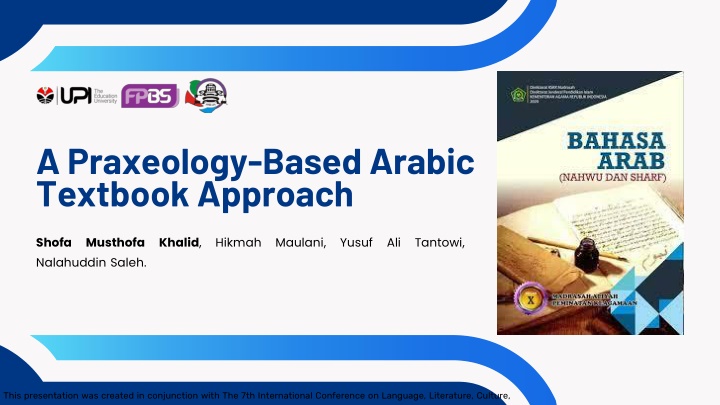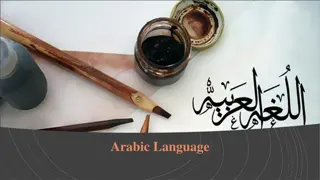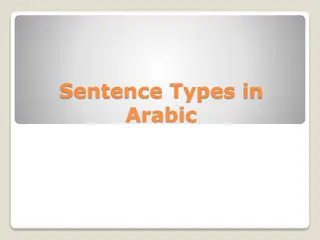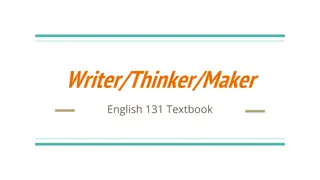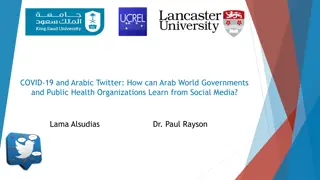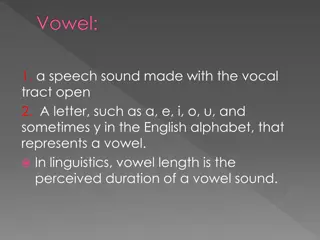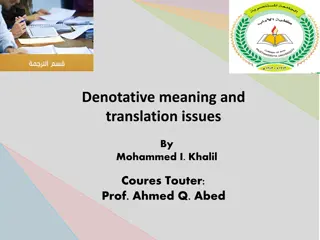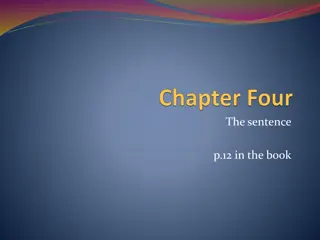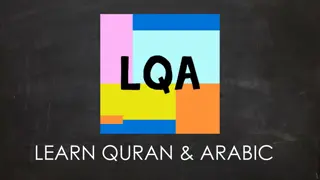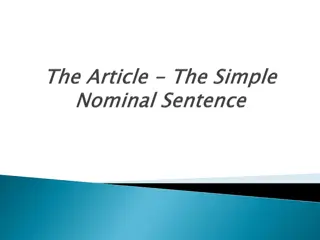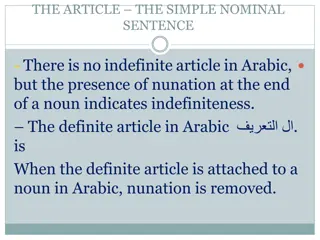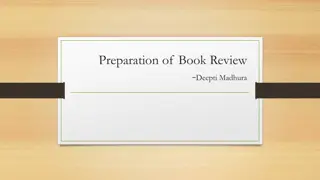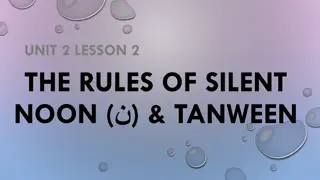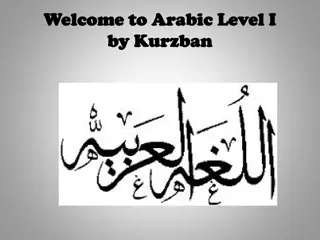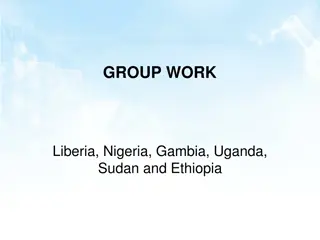Praxeology Approach in Arabic Textbook Development
Praxeology approach emphasizes the integration of theory and practice in creating relevant Arabic textbooks for Madrasah Aliyah level. This research explores the alignment between content and pedagogical methodologies to enhance student learning outcomes.
Download Presentation

Please find below an Image/Link to download the presentation.
The content on the website is provided AS IS for your information and personal use only. It may not be sold, licensed, or shared on other websites without obtaining consent from the author.If you encounter any issues during the download, it is possible that the publisher has removed the file from their server.
You are allowed to download the files provided on this website for personal or commercial use, subject to the condition that they are used lawfully. All files are the property of their respective owners.
The content on the website is provided AS IS for your information and personal use only. It may not be sold, licensed, or shared on other websites without obtaining consent from the author.
E N D
Presentation Transcript
A Praxeology-Based Arabic Textbook Approach Shofa Nalahuddin Saleh. Musthofa Khalid, Hikmah Maulani, Yusuf Ali Tantowi, This presentation was created in conjunction with The 7th International Conference on Language, Literature, Culture,
INTRODUCTION Praxeology Approach This praxeology approach is researchers with the consideration that in the praxeology concept, this practice and theory must be related not something independent so that the analysis carried out is not only one-sided and the results are objective (Kholipah, 2021). used by Finding the problem One of the factors that influence this is textbooks that are considered less relevant for the Madrasah Aliyah level and the content of the material is difficult understand. The gap between the problems and textbooks has important. However, the textbook was the other way around, namely, it was felt difficult for the participants. So this book has been selected by researchers. for students to Textbooks Urgency A good textbook must be relevant and support the implementation curriculum (Hidayah, 2022). The urgency of textbooks in learning is contained in the Regulation of the Minister of Education and Culture of Indonesia No. 8 of 2016. of the
Grand Theory Praxeology itself means activities or human activities that are carried out intentionally (Boudad et al., 2018; Cavalcante & Huang, 2022). Chevallard in Cavalcante & Huang (2022) states that basically, no human action exists without clarity or justification, partly or wholly made to be understood and accounted for, including specialization in Arabic textbooks. Practical matters such as the use of these textbooks are relevant or not in everyday life, especially in the world of education require logos or knowledge to support this praxis (Putra et al., 2021). Praxeology Approach According to Camel in Ainiy & Isnainiyah (2021), textbooks are books that contain information to achieve the desired educational goals both in terms of cognitive, affective, and psychomotor and are presented systematically, to teach certain subjects within a certain period. Arabic Textbooks This presentation was created in conjunction with The 7th International Conference on Language, Literature, Culture,
THE DATA COLLECTION TECHNIQUE Use existing data primary data sources and secondary data sources 01 sources, namely METHOD The research method used in this research is a descriptive method literature study design. qualitative- with THE DATA ANALYSIS TECHNIQUE Data reduction, conlusion/verification. a 02 data presentation, RESULT DATA This research produces and processes descriptive data. 03 This presentation was created in conjunction with The 7th International Conference on Language, Literature, Culture,
RESULT AND DISCUSSION The praxeology approach demands harmony between practice and theory. The material for the contents of the book which is presented in 8 chapters with each having a different topic is aligned with the applicable curriculum with overall supporting material, there is also an elaboration of learning objectives and assessment instruments in each chapter. However, a number of things are lacking in terms of content and material consistency, as well as supporting discussions. This results in not fulfilling the understanding of the theory given and the practice that should result from learning. After an analysis of the content and material presented in the textbook, the following is the conclusion of the analysis carried out by looking at several aspects, including: Learning objectives and learning materials that must be related to praxis or real-life situations. Also, learning methods must be following the objectives and learning materials. And the evaluation of learning must be following the objectives, materials, and learning methods, with the following explanation;
RESULT AND DISCUSSION Learning objectives must be related to praxis or real-life situations involving the use of Arabic. Good goals can prepare students to deal with these situations in everyday life. On paper, this book has a purpose-orientated real-life situation. In the form of theories that give birth to practices as well as references for ways of thinking, behaving, and acting in everyday life, which can then be transformed into social-society life in the context of the nation and state. Learning materials should cover a variety of real-life situations involving the use of Arabic. The material must be well organized and according to students' difficulty levels. Good material must be relevant to the learning objectives and can help students understand and master Arabic better. But in reality, the material presented is less relevant to everyday life. It could even be considered a burden on students and teachers. The material presented is not well structured, so there is no harmony or connection between one chapter and another.
RESULT AND DISCUSSION Learning methods must be following the objectives and learning materials. Learning methods must involve students actively in Arabic practice and provide direct experience in real-life situations. Good learning methods can help students understand and master Arabic better. In practice, this book does not facilitate overall student involvement, because the material does not direct students to be active in practice. The last is the evaluation of learning which must be following the objectives, materials, and learning methods. Learning evaluation should measure students' ability to use Arabic in real-life situations. A good evaluation can provide useful feedback to improve students' ability to use Arabic.
CONCLUSION From the results of an analysis of the Class X Teaching Arabic Language Textbook published by the Directorate of KSKK Madrasah of the Ministry of Religion of the Republic of Indonesia in 2020 with this praxeology approach, the researcher has concluded that this book has not been said to be feasible and suitable for use by students as teaching material that can support the achievement of goals learning Arabic, both in terms of theory and practice. Difficult-to- understand material, minimal discussion, and less or even less attractive design make this book less relevant to students and less interactive. This presentation was created in conjunction with The 7th International Conference on Language, Literature, Culture,
THANK YOU This presentation was created in conjunction with The 7th International Conference on Language, Literature, Culture,
